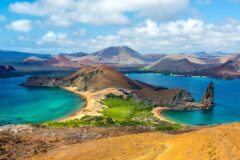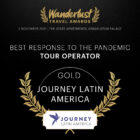Private Journeys
Active Patagonia: Classic treks in Argentina and Chile
14 days
from £4,600pp

Overview & Highlights
Low-altitude trekking through Patagonia's glaciated landscapes on the W Trek in Chile's Torres del Paine National Park and the M Trek in the Fitz Roy massif in Argentina's Los Glaciares National Park to discover the pinnacles of the region's natural scenery.
- Short 'W' Trek: 3 days of guided walking in Torres del Paine National Park
- The 'M' Trek: 2 days of guided walking and camping in the Fitz Roy mountains
- Boat trip on Lago del Desierto
On this Patagonia trekking holiday, savour stretches of the two most famous hikes, the W Trek in Chile and the M Trek in Argentina.
The hikes are quite challenging: walk for several hours over tricky, sometimes steep, terrain. Good weather can’t be guaranteed in a region of fast-changing climatic conditions, but in the southern summer – November to March – you have a good chance of catching some clear, sunny days.
Trekking is one of the best things to do in Patagonia, a vast and scarcely-populated wilderness of outstanding natural beauty which straddles the Andean border of southern Chile and Argentina. It is a primeval land of towering granite peaks, frontier-bending expanses of windswept pampa pitted with sparkling glacial lakes, and a huge domed sky which can be egg-shell blue calm or torn apart by angry clouds. There’s a well-developed and expanding infrastructure to cater for the domestic and international demand for outdoor adventures, especially trekking.
Outline itinerary
Day 1
Arrive in Santiago. Transfer to your hotel in the Providencia district.
Day 2
Fly to Punta Arenas, transfer to your Camp in Torres del Paine National Park.
Day 3
Trek along the Valle del Francés – part of W Trek.
Day 4
Hike towards the Grey Glacier – part of W Trek.
Day 5
Hike to the foot of the towers, the “Torres” del Paine.
Day 6
By public coach to El Calafate, Argentina.
Day 7
Guided excursion to Perito Moreno Glacier and boat trip.
Day 8
Transfer to El Chaltén in Fitz Roy mountains.
Day 9
Start the M Trek; hiking in the Rio Blanco valley, camp overnight.
Day 10
Trek to the Laguna Torre, overnight in El Chaltén.
Day 11
Boat on Lago del Desierto with walking options near Vespigani Glacier. Return to El Calafate.
Day 12
Fly to Buenos Aires, transfer to city-centre hotel.
Day 13
At leisure in Buenos Aires.
Day 14
Transfer to the airport for international flight home.
Itinerary
Day 1
Arrive in Santiago. Transfer to your hotel in the Providencia district.
Your hotel is in the pleasant residential and commercial quarter of Providencia. Santiago is set in a broad valley between ranges of the Andes, with lofty snow-capped peaks, and a smaller coastal range with a distinctly Mediterranean feel. Santiago is a huge metropolis, a mix of the old and the contemporary, with quarters of tree-lined avenues and affluent tranquillity and others full of commercial bustle.
Poorer districts sprawl on the outskirts. The historic core, although small, has some notable buildings of cultural significance.

Day 2
Fly to Punta Arenas, transfer to your Camp in Torres del Paine National Park.
Fly to Punta Arenas in southern Patagonia (4-5hrs). On a clear day you have other-worldly views of the swirling meringue of the southern icecap, its fjords, volcanoes and glaciers. Approaching Punta Arenas you see the rust-brown stain of the Patagonian steppes, pitted with small lagoons stretching out towards the Straits of Magellan. The region’s fortunes were briefly revived during gold rush, but the sheep-rearing business has never really recovered from the collapse of the price of meat and wool.
Drive on into Torres del Paine National Park. The scenery becomes more dramatic as you approach the towering massif which looms up on the horizon./p>
This superb wilderness is dominated by a monumental granite massif of smooth rock towers and icy pinnacles. Milky blue and gem-sharp emerald lakes, sinuous rivers, glaciers and wind-scoured steppes have created a remarkable and unique environment. Declared a biosphere reserve by UNESCO, the area is a natural habitat of over 150 species of birds (flamingos, condors, eagles and ostriches) and 25 species of mammal (including guanacos, armadillos, silver foxes and pumas). Guanacos graze peacefully while ostriches scamper across the plains and condors soar above.

Day 3
Trek along the Valle del Francés – part of W Trek.
Head off on a part of the “W” trek, so named after the shape of the route. You’ll set off on a beautiful trek to Valle Francés (French Valley) along a steep trail which infiltrates the very heart of the Paine Massif. How deep you go depends on the groups’ rhythm. An active walk leads you to the hanging bridge over the Rio Francés at the foot of the south-eastern face of the massif, where there is a truly stupendous view.
Next, you continue up to the upper section of the valley. Here you’ll picnic and rest for a while. An optional trek to the remote, bleaker Mirador Britanico is possible if members of the group don’t want to rest. After lunch you descend through a rippling terrain of mixed grassland and light forest until reaching the Paine Grande campground on the peaceful shores of turquoise Lake Pehoe, with access to warm showers and a hot meal.

Day 4
Hike towards the Grey Glacier – part of W Trek.
Hike along the shores of Lake Pehoe to the northern end of glacial Lago Grey. The lake’s chilly waters are dotted with icebergs which have broken off from the wall of Glacier Grey which plugs the lake. Board the boat and sail to the forbidding blue face of the glacier. There’s plenty of time to marvel at this calving ice monster during the boat ride across the lake. From Lago Grey’s southern end you transfer to the Camp.
In poor weather, you’ll trek up to the sightseeing point offering a spectacular view of the glacier. Then you’ll return on foot to Paine Grande and take a catamaran to Pudeto’s dock.

Day 5
Hike to the foot of the towers, the “Torres” del Paine.
The goal today is to complete the most celebrated trekking trail in Torres del Paine.Walk towards Hostería Las Torres and join the uphill path to Ascencio valley on the towers’ eastern face. Emerald green southern beech forests and rustling streams border the trail towards the valley.
Climb the steep moraine, a mass of boulders leading towards one of the world’s most famous views overlooking the towers, gigantic vertical slabs of rocks rising like an open hand towards the sky. These are the remains of a great cirque sheared away by the forces of glacial ice. After an uphill slog, the towers eventually come into full view, rising majestically before you, with the glacial lake visible below. After feasting on the view and your picnic, you backtrack along the same trail through Ascencio valley.

Day 6
By public coach to El Calafate, Argentina.
It’s an all-day public coach journey towards and over the frontier to Argentina across the bleak and scantily-populated Patagonian steppe, but the beauty of the mountainous scenery is staggering.
In the afternoon you reach the shores of the milky turquoise Lago Argentino, and the little town of El Calafate, where you are based for a couple of days. This resort town is on the southern shore of the lake. Tourism in the last twenty years has transformed it into a bustling entrepôt for access to the nearby scenery of glaciers, lakes and impossibly steep peaks. It still has a bit of a frontier feel, though it is very busy in summer.

Day 7
Guided excursion to Perito Moreno Glacier and boat trip.
Guided excursion to Perito Moreno glacier. Depart from El Calafate to Los Glaciares National Park, a 90min drive to the walkways and viewing platform overlooking the glacier. The thundering shards of falling ice are a breath-taking spectacle as you pass at a safe distance along the walkway in front of the Canal de los Tempanos, which separates Brazo Rico from the main part of the lake.
The glacier is 5km wide and stands 60m above the surface of the lake. Its ice mass is fed by the southern continental ice field from the west, and from other smaller glaciers in the vicinity.
In the afternoon, board the Safari Nautico or Moreno Fiesta for an hour-long cruise on the lake beneath the glacier, with a commentary. Alternatively, you can just walk and contemplate, away from the other visitors.

Day 8
Transfer to El Chaltén in Fitz Roy mountains.
A 3hr journey from El Calafate takes you deep into Los Glaciers National Park. Wildlife to look out for includes guanaco and the ostrich-like rhea. The road skirts the turquoise waters of Lago Viedma, with views of the Viedma glacier.
On a clear day, an hour before arriving in El Chaltén, the whole of the Fitz Roy massif comes into view – a fantastic taste of what lies ahead. Transfer to your hotel.
Make preparations for tomorrow’s start of a moderate intensity, fully guided trek reaching the Piedras Blancas glacier, viewpoint of the striking Fitz Roy mountain face, continuing along the Cerro Torre valley with glimpses of its spectacular centrepiece of jagged peaks. Finally there’s an ice trek over the Viedma glacier using crampons.

Day 9
Start the M Trek; hiking in the Rio Blanco valley, camp overnight.
The snow-strafed, almost skeletal, jagged peaks which rise up from a harsh, oft barren landscape around Mount Fitz Roy, frame the territory of some of Latin America’s most dramatic, visually jaw-dropping trekking routes. You’ll see some of the best sights in this 2 day hike.
A 30mins’ drive takes you along the banks of the Rio de las Vueltas to the Blanco river and the start of this private two-day trek. There are good views of the northeast face of Mount Fitz Roy, the crimson Mount Electrico and the stunning, ice-jacketed Mount Aniversario
From here, the trail takes you into a dense sub-Antarctic beech tree forest, the bright green foliage a welcome relief from the harsh rocky slopes. The trail traces the banks of the Blanco river before rising up through the valley. There are great views of Piedras Blancas glacier, which descends from the heart of a granite labyrinth into a small lagoon and thence into the chilly waters of Rio Blanco.
Continue walking along the valley, cross the river and rise to discover expansive views over silvery Laguna de los Tres: this is widely agreed to be one of the continent’s most breath-taking vistas. Enjoy your packed lunch with the face of Mount Fitz Roy spread out in front of you.
Hike back to camp at Capri lagoon. There are no running water or shower facilities; however, water is provided for washing. Campsites have a long drop-style toilet. All this is a small price to pay for the breathtaking wilderness scenery. You do not need to carry a tent or camping gear as campsites will already be set up.

Day 10
Trek to the Laguna Torre, overnight in El Chaltén.
Start hiking south and over a pass into the Fitz Roy river valley. You’ll pass the Madre y Hija lagoon (mother and daughter, a larger lake attached to a smaller one), an expanse of rippling blue water fringed by the rugged beech forested slopes of steep, battleship-grey and tawny mountains.
Hike through the gnarled, fairy-story woodland to Mount Torre valley where on a clear day you will observe the vertical slopes of Mount Torre, one of the world’s most challenging climbs. Arrive at Torre Lagoon and pause for a picnic overlooking this awesome sight. Trek back to El Chaltén following the Fitz Roy river through stunted sub-Antarctic forest.

Day 11
Boat on Lago del Desierto with walking options near Vespigani Glacier. Return to El Calafate.
Today’s trip takes you to an isolated reserve in the northern section of Los Glaciares National Park. A landscape of brooks, lagoons and waterfalls framed by Mount Fitzroy, the region is a walker’s paradise. Arriving at Lago del Desierto, a boat takes you to the northern section of the lake, passing the distant Creston and Huemul glaciers. A choice of self-guided walking trails leads into the fairytale native forest. An English-speaking guide will be on hand to advise on the trail options, which may take you close to the Vespignani glacier or reveal views of mount Fitz Roy. Return to El Chalten in the afternoon, and onwards to El Calafate and overnight.

Day 12
Fly to Buenos Aires, transfer to city-centre hotel.
Fly to Buenos Aires. The capital is an elegant, cultured and cosmopolitan city famed for its interesting museums and the fascinating port district of La Boca, with its cobbled streets and brightly painted houses. It was here that the tango was born, and Diego Maradona honed his footballing skills.
The centre of town is home to the colonial heartland, government buildings and churches, as well as chic shopping districts, which have a nostalgic Parisian feel. The bohemian quarter of San Telmo is full of quaint old houses interspersed with antiques shops, tango bars and classy restaurants.
Slightly further out of the centre is the Recoleta district, even more evocative of the French influence, where Evita Perón was laid to rest.

Day 13
At leisure in Buenos Aires.
At leisure in Buenos Aires. Discover the classic places specified above, or stroll around Puerto Madero, the refurbished port district where former dock installations and features have been preserved alongside a string of excellent restaurants and loft conversions.
Beyond the city limits, consider a trip across the River Plate to Colonia in Uruguay. Travel along a forest-fringed estuary, dotted with upmarket residences, to this peaceful little port, where you can wander among cobbled streets lined by colonial houses, or have a meal or drink in the yacht club.

Day 14
Transfer to the airport for international flight home.
Essentials
Tour info
Transport
2 flights (4-5hrs); 4 scenic road journeys (longest 7hrs).
Accommodation
In Santiago and Buenos Aires you’ll be staying in mid-range hotels. At the Eco Camp you’ll sleep in igloo-type tented domes. The rooms have either double or twin beds and shared bathroom facilities with hot water. During your Torres del Paine trek, 1 night is in tents at a campground with access to shower facilities and hot water.
In El Chaltén you stay in an alpine style lodge at the base of snow-capped mountains. One night is spent basic camping in tents on the M Trek.
Meals
Breakfast daily; lunch day 11; full board days 3-5, 9, 10.
Guides
We carefully select our local partners, some of whom we have worked with for over 25 years. Their English-speaking guides understand the expectations of our clients very well, and are consistently singled out for praise by the latter on their return.
Summary Of Nights
14 days, 13 nights: Santiago 1; Torres del Paine National Park 4; El Calafate 2; El Chaltén 1, camp 1; El Chaltén 1; El Calafate 1; Buenos Aires 2.
Currency
The unit of currency in Chile is the Chilean Peso; in Argentina it is the Argentinean peso.
How To Take It
Cash machines are available in all major cities and towns, and so taking a debit or credit card with a PIN number is the most convenient way of withdrawing money while on your trip, and in most shops and restaurants you can also pay by card. However, since cards can get lost, damaged, withheld or blocked, you should not rely exclusively on a card to access funds. We recommend that additionally you take a reasonable quantity of US dollars cash (no more than is covered by your insurance), which you can exchange into local currency, and possibly some travellers’ cheques (American Express are the most widely accepted), though these are gradually falling out of use. Dollar bills should be in good condition, soiled or torn bills may be refused. You can take sterling, but the exchange rate is not always competitive or even available, restricting the number of places where you can change money.
For our latest currency advice for Argentina please see our FAQs section.
Daily Spend
It is very difficult to give a guideline for essential expenses but a budget of around US$40 for the few days when you are not on the trekking excursions will cover food, drinks and the odd souvenir. Eat at the best restaurants and you will pay more.
Tipping
Tips are expected and local guides often rely on their tip as a significant proportion of their income.
Most service industry workers will expect a tip of some kind and so it is useful to have spare change for hotel porters, taxi drivers and the like. It is common to leave 10 – 12% in restaurants.
Insurance
Travel insurance is essential.
Details of our recommended policy can be found on our Travel Insurance page.
Visas
Holders of a full British passport do not require a visa, although passports must be valid for at least 6 months after the trip begins. Anyone with a different nationality should enquire with us or check with the relevant consulate.
If flying to the US, or via the US you will need to fill in your online ESTA application.
Airport Taxes
If you have purchased your flights through Journey Latin America, the international departure tax is usually included in the ticket.
Trip Suitability
This is an active outdoor journey. There are a couple of public coach rides, and 2 internal flights.
The holiday includes hikes in rocky and hilly terrain. You need to be fit and have some hiking experience. Be prepared for camping in basic, but comfortable fixed tents in Chile and tents for a night in Argentina.
Climate
Winter in the Southern Hemisphere is between May and September. In Santiago and Buenos Aires, temperatures can be cool (5°C to 15°C). While sunshine is possible, so is rain. Spring and autumn temperatures, October to November and March to April respectively, are between 15 and 25°C and there is a good deal of pleasant sunshine. January and February are hot, around 30°C.
In the Torres del Paine National Park, the best months for hiking are March to April. It can be quite busy in summer (December to January). Days are long and mild then but it can be windy, as in spring (September to October).
In El Calafate and Los Glaciares National Park the best months for hiking are March and April, when the autumn foliage is stunning. Many hikers also visit in summer – December to January – along with non-trekkers so it can be busy. Days are long and mild then but it can be windy, as in spring (September to October).
Clothing And Special Equipment
Bring practical, comfortable clothing and a light-weight jumper. If you plan to eat in smart restaurants, although clothing is not formal (no need for jacket and tie), something quite smart would be appropriate.
For hikes, light and preferably waterproof walking boots with good grip are essential. Protective clothing such as a fleece and GoreTex-type breathable and waterproof outer shell are essential. You may need a sun hat and also a woolly one, gloves and a scarf. That said, it can be hot in the summer, so bring along some shorts and a T shirt and be prepared to carry the rest!
In Los Glaciares National Park, for the M Trek we recommend a small rucksack to carry your personal items, sleeping bag and lunch, or you can hire a porter, payable locally, to carry your things. All camping gear will be provided. (Note that you will be carrying your own personal gear during this 3 day trek).
Hiking poles are also an asset.
Please get in touch with the office before departure if you have any doubts. Good equipment is very important and hard to come by in Latin America.
Vaccinations
Preventative vaccinations are recommended against the following: typhoid; polio; tetanus; hepatitis A. For specific requirements you must consult your GP.
You can also find helpful information on the Travel insurance page.
What's included in the price
- Services of our team of experts in our London office
- Services of Journey Latin America local representatives and guides
- All land and air transport in Latin America
- Accommodation as specified
- Meals as specified
- Walks as specified, including entrance fees
Included Excursions
- Short 'W' Trek: 3 days of guided walking in Torres del Paine National Park
- The 'M' Trek: 2 days of guided walking and camping in the Fitz Roy mountains
- Boat trip on Lago del Desierto
What's not included in the price
- Tips and gratuities
- Meals other than specified
- Airport taxes, when not included in the ticket
- Optional excursions


































